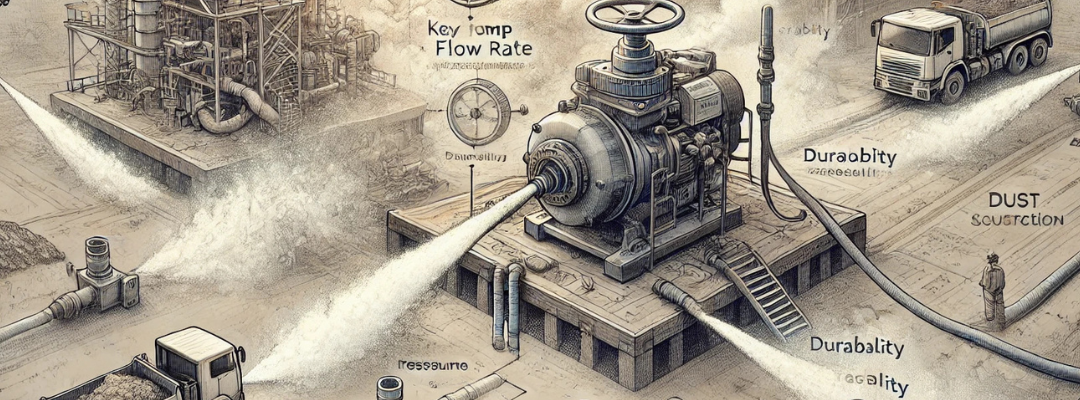Selecting the right pump for a dust control system requires understanding the specific needs of the application, such as the type of dust, environment, and the system’s water requirements. Here are the key factors to consider when choosing the right pump for a dust control system:
1. Flow Rate
- Determine the required flow rate based on the size of the area to be covered and the amount of water needed for effective dust suppression. Flow rates are typically expressed in gallons per minute (GPM) or liters per minute (LPM).
- Low-Flow Systems: Suitable for smaller areas or systems that use misting or fogging nozzles, which require lower water volume.
- High-Flow Systems: Ideal for larger areas or applications that need a significant amount of water, such as mining, quarrying, or construction sites.
2. Pressure Requirements
- Low-Pressure Systems (20-100 psi): For general dust suppression, lower pressure systems may be sufficient. These are often used with sprinkler systems or gravity-fed systems.
- High-Pressure Systems (100-1500 psi): High-pressure pumps are needed for misting or fogging applications where fine water droplets are required for efficient dust control. High pressure helps atomize the water into small particles that trap dust effectively.
- Ultra-High Pressure (2000 psi and above): Used in specialized dust control systems, such as those in cement or coal industries, where dust is extremely fine, and effective control requires fine misting.
3. Pump Type
- Centrifugal Pumps: Common for handling high water flow rates at low to medium pressures. They are efficient for large-scale dust control systems, such as those in quarries or construction sites.
- Diaphragm Pumps: These are ideal for systems requiring precise dosing of water or chemicals for dust suppression, often used in smaller systems with lower flow rates.
- Positive Displacement Pumps: These pumps provide a consistent flow rate regardless of system pressure, making them suitable for applications that require consistent misting or fogging. They are commonly used in high-pressure systems.
- Peristaltic Pumps: If chemicals are added to the water for dust control (such as wetting agents or surfactants), peristaltic pumps are useful for dosing chemicals accurately without contaminating the pump.
4. Material Compatibility
- The pump should be made of materials that are resistant to corrosion, especially if the water contains additives (such as wetting agents, surfactants, or chemicals) or if the environment is corrosive (such as in mining or cement plants).
- Stainless Steel or polypropylene (PP) are commonly used materials for pumps in dust control systems to ensure longevity and resistance to wear and corrosion.
5. Durability and Reliability
- Dust control systems often run continuously, so the pump must be durable and capable of handling long periods of operation with minimal maintenance. Choose pumps with a reputation for longevity and robustness.
- Heavy-Duty Pumps: For industrial environments such as mining, coal handling, or cement plants, select pumps that are specifically designed for harsh conditions and abrasive environments.
6. Energy Efficiency
- Select pumps that are energy-efficient to reduce operational costs, especially in large systems where pumps may run for extended periods.
- Look for pumps with variable speed drives (VSD) or energy-efficient motors to optimize power consumption based on the system’s demand.
7. Pump Size and Configuration
- The physical size of the pump should fit within the available space for installation. If space is limited, opt for a compact pump design.
- Consider whether the pump will need to be mobile or stationary. Mobile systems may require lightweight or portable pump models.
8. Self-Priming Capabilities
- For applications where the pump is located above the water source, a self-priming pump is essential to ensure the pump can automatically begin operation without manual intervention.
9. Maintenance and Accessibility
- Choose pumps that are easy to maintain and have readily available parts. Pumps with fewer moving parts or accessible components are easier to maintain, reducing system downtime.
10. Noise and Vibration Levels
- Some environments may require pumps with low noise and vibration levels, especially if the dust control system is used in urban or noise-sensitive areas.
11. Water Source
- The quality of the water source can impact the type of pump needed. If the water contains impurities, sediments, or particulates, the pump should be able to handle these without clogging. Alternatively, the system may need to include filtration before the water reaches the pump.
12. Application-Specific Considerations
- Mining and Quarrying: These environments require pumps capable of handling large volumes of water at high pressure to control dust over expansive areas.
- Construction: Construction sites often need portable, high-pressure pumps to suppress dust in specific areas.
- Agriculture: Dust control on farms may require pumps to deliver water in misting systems to reduce airborne dust and protect crops.
Recommended Pump Types by Application:
- Misting or Fogging Systems: For fine mist applications in areas like coal handling or cement plants, use high-pressure centrifugal pumps or diaphragm pumps capable of producing atomized water droplets.
- Sprinkler Systems: For broader coverage in areas like quarries or construction sites, use centrifugal pumps that provide high flow rates with moderate pressure.
- Chemical Additives: For applications requiring additives or chemicals, peristaltic pumps or diaphragm pumps are ideal due to their dosing accuracy and resistance to corrosion.
By carefully considering the flow rate, pressure, pump type, material compatibility, and system requirements, you can select the right pump for your dust control system to ensure efficient and reliable operation.

